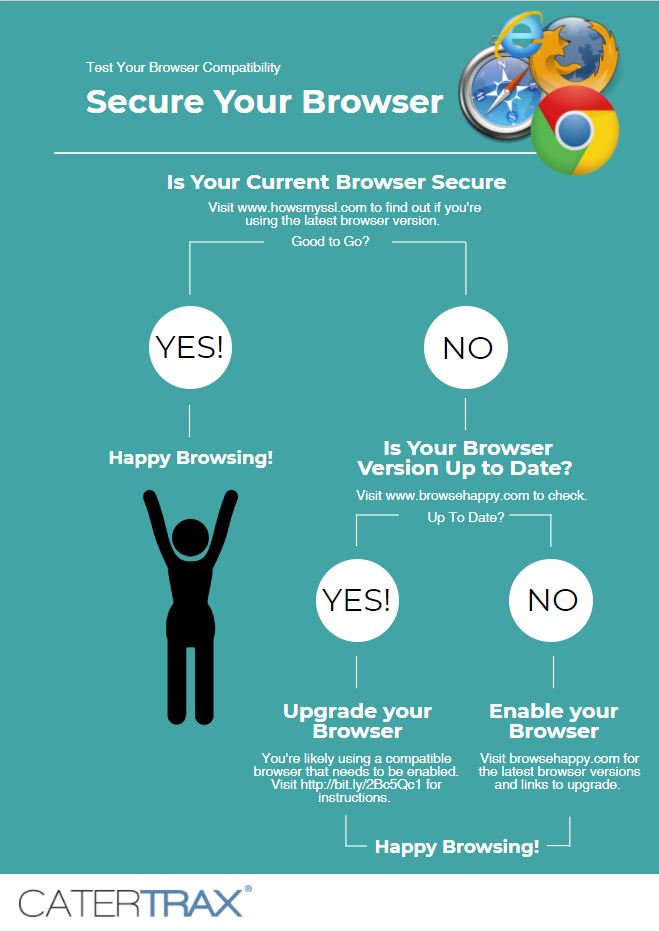TLS Updates: What You Need to Know
Make your browser compatible with TLS 1.1 and higher to ensure your online information stays safe.
TLS puts the “S” in HTTPS when you’re visiting secure websites, like this one (check out our URL!) but what does that even mean? Per Wikipedia: Transport Layer Security (TLS) and its predecessor, Secure Sockets Layer (SSL), are cryptographic protocols that provide communications security over a computer network. Yikes – we don’t blame you if you read that sentence a few times and are still scratching your head. The internet is a flurry of information being exchanged all over the world through web browsing, emailing, instant messaging, online payments, and on and on. Throw in all the passwords and personal and financial information flying around and that’s where security, like TLS, comes into play.
When information is transmitted online, it’s basically just two computer applications communicating with each other. Think of it, for example, as the “link” between the TRAX Platform and a customer’s mobile phone when they place a take-out order. Security protocols like TLS (the most popular protocol) are applied to web applications, like the TRAX Platform, to ensure that “link” is secure and that all the sensitive customer information, like account details and payment info, are private and protected.
The TRAX Platform is secured by TLS because it ensures that when our clients and their customers connect with the TRAX Platform one or more the following things is true:
- The connection is private. Information, like payment methods, is encrypted which obscures the content when it is sent, for example from that customer’s mobile phone to the administrator.
- Host (clients and customers) and/or the Server (The TRAX Platform) can be authenticated. This is a fancy way of saying the security protocol checks to make sure everyone is who they appear to be.
- Integrity is ensured. When information is exchanged, TLS has a mechanism in place to prevent undetected loss or alteration of information, detecting message tampering and forgery.
So, why all the talk about TLS now?
The National Institute of Technology has found room for improvement in early versions of TLS/SSL. To continue to ensure users are experiencing the utmost security, the PCI Security Standards Council is requiring TLS protocols be updated to 1.2 or higher by June 2018. Many web applications, including the TRAX Platform, are upgrading to meet the new security standards.
Secure Your Browser!
Modern web browsers will begin prohibiting SSL connections, preventing users of these browsers from accessing web servers that have not upgraded. This means everyone will need to ensure their browser is compatible because actions, like making a payment through the TRAX Platform, will be otherwise restricted. The good news is increased security is never a bad thing and while technology companies like CaterTrax have had some heavy lifting to do, this update should be painless for end users. Your main concern is ensuring your browser is compatible with TLS 1.1 or higher. We created this simple infographic to help you with the transition.

The Resources:
- Check TLS Client: https://www.howsmyssl.com/
- Check Browser Version/Upgrade to Latest Version: https://browsehappy.com/
- Enable Browser: https://knowledge.geotrust.com/support/knowledge-base/index?page=content&id=INFO3299&pmv=print&actp=PRINT
- Or watch this short instructional video:


September 27, 2022 @ 10:55 pm
It’s really just two programs talking to each other when data is sent over the internet.
December 23, 2022 @ 4:31 am
Insanely addicting! Great work.
March 3, 2023 @ 3:21 am
You’ll have to have me as a follower since the information you offer is really true, accurately portraying the situation in an objective manner, and it’s highly helpful for the development of society as a whole.
July 14, 2023 @ 4:17 am
“I just had to leave a comment and express how much I enjoyed this blog post. Your writing not only educates but also entertains. It’s rare to find a blog that strikes the perfect balance between informative and engaging. Keep up the fantastic work!”
July 16, 2023 @ 3:04 am
Amazing article thanks